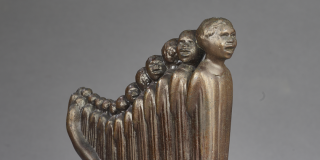
The Brooklyn of the Future, supplement published with Brooklyn Daily Eagle
New York: Brooklyn Daily Eagle, April 2, 1903
Lionel Pincus and Princess Firyal Map Division
The Brooklyn of the Future, supplement published with Brooklyn Daily Eagle
In 1890, before the consolidation of the five boroughs, Brooklyn was the fourth largest city in the country, and the “The Brooklyn of the Future” proclaimed by this 1903 map promised continued development—growth that was dependent on the expansion of public transportation. The first steam lines in Brooklyn had been established by private developers looking to benefit personal ventures. The establishment in 1896 of the holding company Brooklyn Rapid Transit (BRT) Corporation, later Brooklyn-Manhattan Transit (BMT), consolidated numerous preexisting steam railroads, elevated lines, and companies. The private Interborough Rapid Transit (IRT) Company managed construction of the first subway line in Manhattan in 1904, a route into the Bronx, and a later extension to Atlantic Avenue, Brooklyn. In the 1920s, New York City established the Independent Subway (IND)—independent of the IRT and BMT companies. A slow consolidation of these entities into a single transit agency began in 1940.
This 1903 map declares the “The Transformation of the Borough,” citing the construction of various bridges, subways, tunnels, and elevated roads. A few are marked nearly complete or in progress, but most are still projected. The text also refers to, among other projects, the creation of sewers, a municipal building, new schools, libraries, and ferry lines—all in the name of making Brooklyn “a Great Industrial Centre.”
: Lionel Pincus and Princess Firyal Map Division
Currently on View at Stephen A. Schwarzman Building
The New York Public Library believes that this item is in the public domain under the laws of the United States, but did not make a determination as to its copyright status under the copyright laws of other countries. This item may not be in the public domain under the laws of other countries. Though not required, if you want to credit us as the source, please use the following statement, "From The New York Public Library," and provide a link back to the item on our Digital Collections site. Doing so helps us track how our collection is used and helps justify freely releasing even more content in the future.






